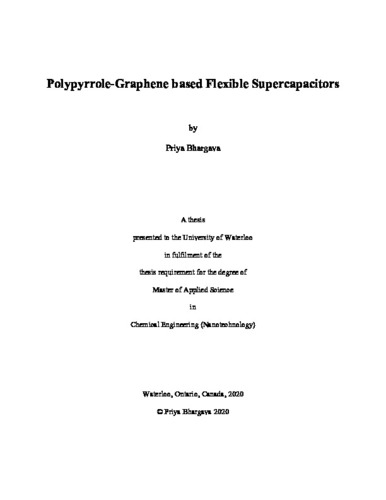| dc.description.abstract | The high interest in wearable technologies has inspired an increased demand for portable, flexible energy storage devices. Currently, most commercial electrochemical energy storage units, such as supercapacitors, are available only in rigid formats, failing to meet the flexibility standards that allow their integration into wearables such as smart textiles and flexible electronics. To achieve flexible supercapacitors, different flexible substrates have been separately reported by various research studies for electrode preparation by coating them with active materials. However, there is a lack of studies comparing these substrates, using the same active material, to investigate their impact on the electrochemical performance of a supercapacitor cell. This can provide important reference and guidance for the design of flexible supercapacitors. Polypyrrole is a popularly used conductive polymer for supercapacitor applications due to their high areal/specific capacitance, energy density and low cost, but they suffer from poor cycling stability. Herein, reduced graphene oxide has been combined with polypyrrole to obtain an optimized electrode configuration with good cycling stability and areal capacitance. Using this electrode configuration, the electrochemical performance of flexible supercapacitor electrodes and full cells constructed with three commonly used substrates- commercially obtained conductive polyester fabric (Cu:Ni-PET), carbon cloth and stainless-steel wire mesh (SSWM), are compared. Particularly, the effects of substrate properties such as conductivity, morphology, wettability on the morphology and electrochemical performance of the resulting polypyrrole-graphene-polypyrrole sandwich structure electrode are investigated in-depth. It is found that the best electrochemical performance is obtained for Cu:Ni-PET based electrodes with a high areal capacitance of 1412 mF/cm² at the current density of 2 mA/cm² and capacitance retention of 96.6% after 3000 cycles. Whereas, carbon cloth-based electrodes show next best performance with 1227 mF/cm², followed by SSWM based electrodes with 1030 mF/cm² capacitance. The supercapacitor cells show similar results, where cells prepared using Cu:Ni-PET show larger areal capacitance, good cycling stability, and better capacitance retention after 4000 bending cycles compared to carbon cloth and followed by SSWM. The best electrochemical performance of Cu:Ni-PET based supercapacitors are mainly attributed to its high conductivity, good wettability, and unique surface morphology as well as excellent bendability. | en |

